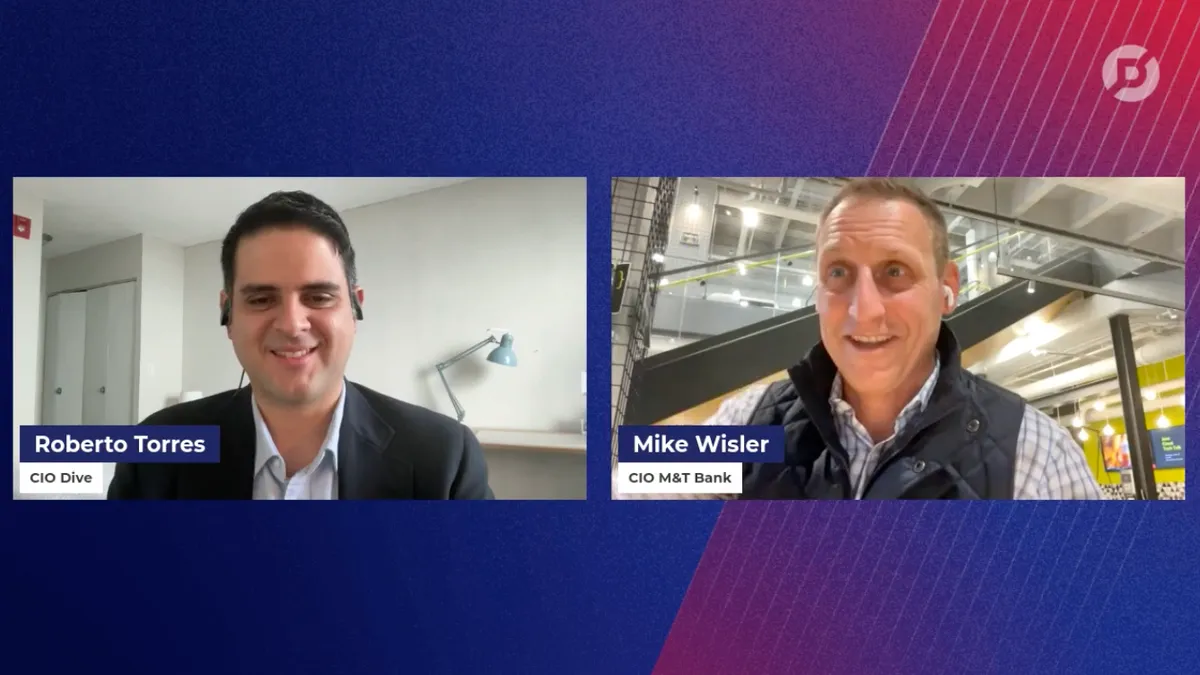Editor’s note: This article draws on insights from a CIO Dive virtual event panel with M&T Bank CIO Mike Wisler. You can register here to watch a replay of the full event, “What It Takes to Run in the Cloud,” here.
Cloud is nearly synonymous with enterprise modernization, an ongoing process encompassing people, processes and technologies.
While cloud’s “as a Service” model largely eliminates geographical barriers to transformative tools, sourcing the talent needed to sustain modernization remains a challenge — particularly outside of traditional tech hubs. This includes Buffalo, New York, where M&T Bank is headquartered.
“Cities like Buffalo are in a race for relevance, and that relevance is almost all about talent — the modern creative class — sometimes technical, but not exclusively technical talent,” M&T Bank CIO Mike Wisler said during a CIO Dive virtual event Wednesday.
In the five years Wisler’s served as CIO, he’s led the company’s charge to cultivate local talent pools and create a regional skills pipeline through community-based data analytics bootcamps, an in-house Tech Academy and a mainframe apprenticeship program.
In cloud, the push to modernize intersects with ongoing competition for tech talent, Wisler said.
“Gone are the days when even the largest of institutions are going to be in the business of infrastructure management,” Wisler said. “There was a period of time when highly regulated, highly conservative institutions and industries like ourselves were hesitant of the cloud, but I think even those days are essentially gone.”
Cloud has been an ally to Wisler in several respects. Outsourcing some of the company's IT has allowed Wisler to move in-house engineers “up the tech stack,” he said, freeing that talent to work on more complex tasks, such as building new software.
User-friendly interfaces and simplified tooling allows early-career technologists who may lack deep engineering skills to ramp up their abilities — another advantage afforded by cloud.
But that ease of prototyping comes with a downside.
“We've modularized technologies such that you may or may not have to have many of the classic fundamentals in order to put something functional together,” Wisler said. Near-term productivey gains can leave technologists without the deeper engineering skills needed for career advancement.
Wisler’s solution hinges on the legacy tech so many financial services companies rely on.
“Some of our older legacy technology is such that it’s become a really rich place for us to take non-traditional talent and teach them the fundamentals in a place where we can see real value and they can learn a lot,” Wisler said.
Wisler also sees his mainframes as a helpful reminder that moving quickly isn’t always the answer.
“I often think running in the cloud is similar to running with scissors,” Wisler said, referring to the perils of hurried adoption. “It is a place that offers an incredible amount of benefits, the ability to engineer much more quickly, the ability to create different patterns of resiliency and security.”
But speed, whether it’s in cloud deployments or tech upskilling, can lead to costly mistakes and misfires.
“One of the lessons that I learned previously and that we’re deploying here is ‘move slow to move fast,'” Wisler said.
Speed will come, said Wisler, when organizations take the time to develop skills, cultivate engineering fundamentals and put controls in place to ensure they are not just lifting and shifting workloads to cloud.















